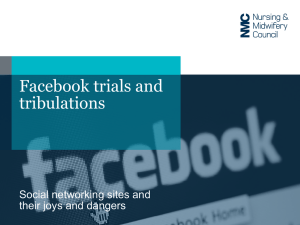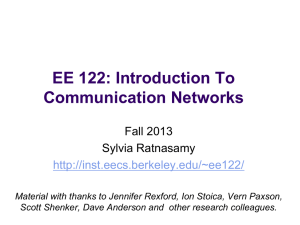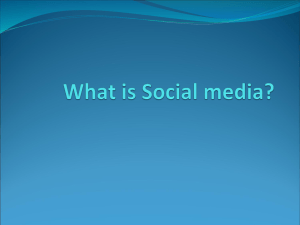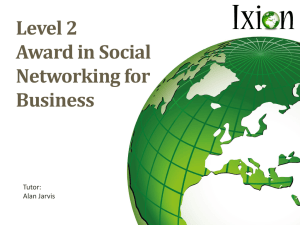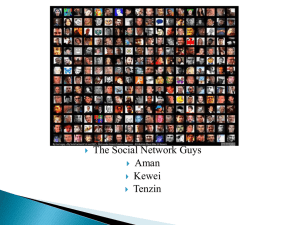Internet
advertisement
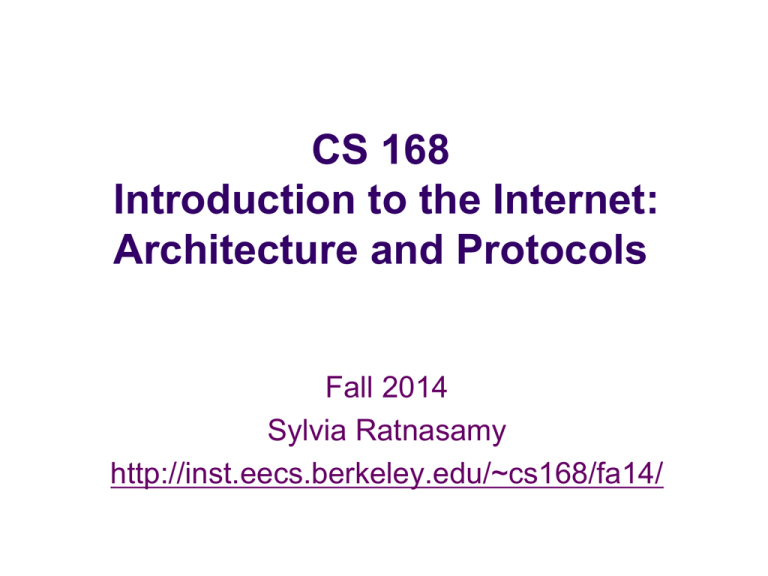
CS 168
Introduction to the Internet:
Architecture and Protocols
Fall 2014
Sylvia Ratnasamy
http://inst.eecs.berkeley.edu/~cs168/fa14/
Today
Introductions
What is (this course on) networking about?
5 minute break
Class policies, administrivia and roadmap
Introductions
Teaching Assistants
Peter Gao
Sangjin Han (co-head TA)
Anurag Khandelwal
Chang Lan
Murphy McCauley
Akshay Narayan
Radhika Mittal (co-head TA)
Shoumik Palkar
Qifan Pu
See the course website for TA office hours and sections
Peter Xiang Gao
2nd year PhD student
Research focus
fault-tolerant network devices
Sangjin Han
Co-Head TA
4th year PhD student
Research focus:
high performance
network software
Anurag Khandelwal
2nd year PhD student
Research focus
cloud computing
Chang Lan
2nd year PhD student
Research focus
programmable routers
Murphy McCauley
2nd year PhD student
Research focus
Software-Defined Networking
Radhika Mittal
Co-Head TA
3rd year PhD student
Research focus:
network congestion control
and queue management
Akshay Narayan
Senior
Research focus
Congestion control in
datacenters
Shoumik Palkar
Senior
Research focus
Programmable routers
Qifan Pu
2nd year PhD student
Research focus
Distributed systems
Instructor: Sylvia Ratnasamy
Ph.D. in Computer Science from UCB in 2002
Worked at Intel between 2002-2011; back at UCB since 2011
Networking has been my research focus throughout
My teaching style
I talk too fast
The more bored you look, the faster I talk
So, stop me with questions!!
Office hours: 4:30-5:30pm Thursday in 413 Soda Hall
Always happy to chat if you have a problem (send email)
What is networking about?
car navigator
heart pacemaker
smartphone
end-system
iPad
Linux server
MAC laptop
Windows PC
16
end-system
switch
17
phone
lines
end-system
cable TV
lines
link
fibers
switch
wireless
links
18
link
phone company
switch
end-system
university net
cable company
Internet Service Provider
19
link
end-system
path
switch
packet
Internet Service Provider
20
facebook
server
world of
warcraft server
instant
messaging
instant messaging
world of warcraft
client
firefox accessing
facebook
21
while (...) {
message = ...;
send ( message, ... );
}
while (...) {
message = receive( ... );
}
Bob
Alice
22
Alice
Bob
23
Alice
Bob
24
Why study the Internet?
The Internet is
transforming everything
The way we do business
The way we have relationships
Wikipedia, MOOCs, search engines
The way we govern and view law
Facebook friends, E-mail, IM, virtual worlds
The way we learn
E-commerce, advertising, cloud-computing
E-voting, censorship, copyright, cyber-attacks
The way we cure disease
Digital health, remote diagnostics
The Internet is big business
Many large and influential networking companies
Cisco, Broadcom, AT&T, Verizon, Akamai, Huawei, …
$200B+ industry (carrier and enterprise alone)
Networking central to most technology
companies
Google, Facebook, Microsoft, HP, Dell, VMware, …
Internet research has impact
The Internet started as a research experiment!
4 of 10 most cited authors work in networking
Many successful companies have emerged from
networking research(ers)
But why is the Internet interesting?
“What’s your formal model for the Internet?” -- theorists
“Aren’t you just writing software for networks” – OS community
“You don’t have performance benchmarks???” – hardware folks
“It’s just another communication network!” – old timers at AT&T
“What’s with all these TLA protocols?” – all
“But the Internet seems to be working…” – my parents
A few defining characteristics
of the Internet
A federated system
The Internet interconnects different networks (>18,000 ISPs)
AT&T
UCB
France
Telecom
One common protocol -- the “Internet Protocol (IP) -- between
users and the network and between networks
A federated system
Interoperability is the Internet’s most important goal
Leads to a constant tussle between business and
technical factors
competing ISPs must cooperate to serve their customers
practical realities of incentives, economics and real-world trust
determine physical topology and path selection
a common protocol is great for interoperability …
… but complicates innovation
Tremendous scale
2.92 Billion users (41% of world population)
1 Trillion unique URLs (in 2008)
294 Billion emails sent per day
1.75 Billion smartphones
1.24 Billion Facebook users
100 hours of video uploaded to YouTube every minute
Switches that move 300Terabits/second (1014)
Links that carry 100Gigabits/second
Enormous diversity and
dynamic range
Communication latency: microseconds to seconds (106)
Bandwidth: 1Kbits/second to 100 Gigabits/second (107)
Packet loss: 0 – 90%
Technology: optical, wireless, satellite, copper
Endpoint devices: sensors, cell phones, datacenters
Applications: skype, live video, gaming, remote medicine,
Users: the governing, governed, operators, selfish, malicious,
naïve, savvy, embarrassed, paranoid, …
Constant Evolution
1970s:
56kilobits/second “backbone” links
<100 computers, a handful of sites in the US
Telnet and file transfer are the “killer” applications
Today
100+Gigabits/second backbone links
5B+ devices, all over the globe
20M Facebook apps installed per day
Asynchronous Operation
Fundamental constraint: speed of light
Consider:
How many cycles does your 3GHz CPU in Berkeley
execute before it can possibly get a response from a
message it sends to a server in NY?
Berkeley to New York: 4,125 km
Traveling at 300,000 km/s: 13.75 milliseconds
Then back to Berkeley: 2 x 13.75 = 27.5 milliseconds
3,000,000,000 cycles/sec * 0.0275 = 84,000,000 cycles!
Thus, communication feedback is always dated
Prone to Failure
To send a message, all components along a path
must function correctly
software, modem, wireless access point, firewall, links,
network interface cards, switches,…
Including human operators
Consider: 50 components, that work correctly 99%
of time 39.5% chance communication will fail
Plus, recall
scale lots of components
asynchrony takes a long time to hear (bad) news
An Engineered System
Constrained by limits of available technology
Link bandwidths
Switch port counts
Bit error rates
Cost
…
Recap: The Internet is…
A federated system
Of enormous scale
Dynamic range
Diversity
Constantly evolving
Asynchronous in operation
Failure prone
Constrained by what’s practical to engineer
Recap: The Internet is…
Too complex for theoretical models
“Working code” needn’t mean much
Performance benchmarks are too narrow
So, what do we need?
We still don’t really know…
No consensus on what constitutes the “correct” or
“best” network design
No consensus on “top 10 problems”
No consensus on the right prioritization of goals
Before you flee…
What we do know
The early Internet pioneers came up with a solution that
was successful beyond all imagining
Several enduring architectural principles and practices
emerged from their work
Architectural principles
Decentralization
[lectures: all]
Packets [lecture# 2]
Statistical multiplexing [lecture 2]
Best effort service [lecture 3]
The “end to end” design principle [lecture 8+]
“Layered” decomposition [lectures: all]
IP as “narrow waist” interface [lecture 8]
What we do know
The early Internet pioneers came up with a solution that
was successful beyond all imagining
Several enduring architectural principles and practices
emerged from their work
But it is just one design
And numerous cracks have emerged over time
want to diagnose problems but federation hides inner workings
want to block unwanted traffic but the network doesn’t authenticate
can’t optimize for different applications or customers
upgrading protocols is deeply painful
What we do know
The early Internet pioneers came up with a solution that
was successful beyond all imagining
Several enduring architectural principles and practices
emerged from their work
But it is just one design
And numerous cracks have emerged over time
As have new requirements
Mobility, reliability, data centers, sensors, …
Hence, networking today is still
debating the big questions...
Packets “circuits”
Statistical multiplexing “reservations”
Protocol layers
A “narrow waist” at the network layer
Best-effort service ”Quality of Service (QoS)”
The “end to end” design principle “middleboxes”
Decentralization “centralize”
Backing up a level
The Internet offers us a lesson on how to reason
through the design of a complex system
What are our goals and constraints?
What’s the right prioritization of goals?
How do we decompose a problem?
Who does what? How?
What are the tradeoffs between design options?
In short: a lesson in how to architect a system
Network Architecture
More about thinking rigorously than doing
rigorous math
More about understanding tradeoffs than running
benchmarks
More about practicality than optimality
Done right, can be a powerful thing
What (I hope) CS 168 will teach you
How the Internet works
Why it works the way it does
How to reason through a complicated
(networking) design problem
Let’s take a 5 minute break
Today
Introductions
What is (this course on) networking about?
5 minute break
Class policies, roadmap, administrivia
Class Workload
Three projects
Three homeworks
Exams:
midterm: October 20 in class
final: December 18, 8-11am, location TBA
closed book, open crib sheet
No lecture on November 26 (for Thanksgiving)
Grading
3 Homeworks
15% (3x 5% each)
3 Projects
40% (10+10+20)
Midterm exam
20%
Final exam
25%
Course graded to mean of B
Topics we will cover
Basic concepts [Lectures 2, 3]
How the “insides” of the Internet work [Lectures 38]
TCP, DNS, HTTP
Crucial lower-level technologies [Lectures 17-20]
IP, DV/LS routing, BGP
How endpoints use the network [Lectures 9-16]
packets, circuits, delay, loss, protocols
Ethernet, wireless
Important new(er) topics [Lectures 21-26]
Three projects
Project 1: Routing (in simple simulator)
Project 2: Reliable Transport (in simple simulator)
Project 3: Build a network firewall
Larger project, in two phases
TAs will handle all project-related questions!
Administrivia: Textbook
J. Kurose and K. Ross, Computer Networking: A
Top-Down Approach, 6th Edition, 2012.
5th Edition ok, but translate the reading assignments
You will not be tested on material we didn’t
cover in lecture or section
Use as a reference and a source of examples
Enrollment and wait list
Class size will not increase
Wait-listed students will be admitted as and when
registered students drop the class
If you’re planning to drop, please do so soon!
Waitlist will be processed in order; seniors get priority
Class communications
Web site: http://inst.eecs.berkeley.edu/~cs168/fa14/
Use your instructional account to hand in assignments
Accounts will be handed out next week
Use Piazza for all other intra-class communication
Assignments, lecture slides, announcements
You should all be signed up by now
Copy Radhika (radhika@cs) and Sangjin (sangjin@cs)
on any emails sent directly to me (sylvia@cs)
Policy on late submissions,
re-grade requests, cheating
Detailed description is on the class website
Summary version:
You may submit assignments late or request re-grades
but to a point, and it will cost you
The policy on re-grades for projects will be announced by
the lead TA on the project and may vary across projects
Your responsibility to keep your code private!
When in doubt about the policy, ask us!
Class Participation
We will post slides ~10minutes before class
Ask and answer questions!!
it helps you understand
it helps others understand
it helps you stay awake
it helps me stay awake
it’s just more fun for all of us
Sit towards the front
Limit electronic access for < 90 minutes
you will have a 5 minute break in the middle to get online
Next Steps
For our next lecture
read 1.1 and 1.3 of K&R
Make sure you are registered with the correct
email address and on piazza
Discussion sections will start on September 10
Sections on Wednesday and the following Monday will
cover the same material
OK to swap sections unless we hit room capacity limits
Any questions?
